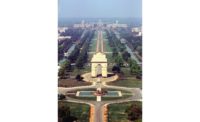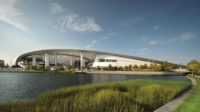Los Angeles, California
On land once inhabited by native Tongva people and, centuries later, by the Hughes Aircraft Company, the planned community of Playa Vista is gradually rising on Los Angeles’s West Side. Here, in the 1940s, Howard Hughes built a private airfield and his famous wooden “Spruce Goose,” an aircraft with the greatest wingspan in history. After a single flight, the Goose was permanently grounded, but controversy over the 1,086-acre tract hovered for decades following Hughes’s death in 1976
A series of developers, as early as 1978, tried to create a mixed-use, live-work community. But endless setbacks ensued. In the 1990s, DreamWorks planned a movie studio, then pulled out. Opposition from environmentalists over wetlands protection and other obstacles followed. The final outcome: Hundreds of acres of wetlands will be protected, limiting the development parcel to 435 acres. Now partially complete, it will enfold the historic Hughes Aircraft buildings as movie-production facilities.
Back in 2007, Michael Maltzan was hired to design two office buildings here (now on hold). In the process, the master developer, Playa Capital, asked him to make studies for a park, part of the complex’s public open space requirements. Maltzan’s ideas — “bridges of program” connecting the surrounding office buildings and future development — convinced Playa Capital to hire him to design the park with landscape architect James Burnett.
Program
The resulting 7.9-acre public park, privately maintained by Playa Capital, includes a basketball court, soccer field, playground, bosque, bocce courts, berm gardens, and a bandshell with an amphitheater lawn.
Solution
Aerial panoramas provide an apt — and telling — introduction to the former site of Hughes’s airfield. As planes approach Los Angeles International Airport, Central Park at Playa Vista comes into view, just three miles from touchdown. The park’s main axis, extending its entire length, recalls Hughes’s runway, with diagonal paths crisscrossing it like taxiways intersecting an airstrip.
From the air or nearby bluffs, the park’s graphic qualities are as striking and unreal as a rendering. Bands of contrasting materials and textures stripe this irregular swath of land with a plaza dotted with circular benches, two wide strips of water, allées of trees, faceted berm gardens, and a lawn sloping down to the bandshell. The berm plantings form swatchlike triangles and trapezoids of color and pattern, pieced together like a collage. “We weren’t trying to mimic nature,” says Maltzan, “but to evoke the spirit of nature in a manifestly constructed place.”
The design playfully manipulates not only the plantings, but also some of the standard-built features of a city park. Here, the “land bridge” over one band of water brings together a blue-surfaced basketball court, a volleyball area, and a candy-green playground — three elements in a quasi-zigzag configuration, behind a veil of vibrant orange chain-link fence. Varied as the transverse zones appear, they are united by the long axis skewering them and crossing the water like a causeway.
At grade, a range of scales modulates the experience of passing from one “outdoor room” to the next. On this level, the diagonal paths that evoke airport taxiways from above perform like walkways in a classic academic campus, connecting people and buildings across a green. En route, a “bento box of activity,” as Maltzan describes the programmatic array, animates the park.
The most traditionally architectural item here is the bandshell. Like the paths, it has an aeronautical quality. A roughly spherical, stretched-fabric object, stealthily perched on two steel feet, it conveys a sense of buoyancy, recalling a moored dirigible, but with ramps extending out, instead of guy wires. Though Maltzan says he finds most fabric structures lacking in spatial complexity, he chose to investigate the possibilities, exploring, for example, translucent versus opaque characteristics of a fiberglass/PTFE membrane. Solid by day, the white shell dematerializes visually by night, glowing like a lantern.
Structurally, the design transforms potentially hefty rings into tracery-like ribs, transferring loads across transmodal struts. The skeleton simultaneously conveys lightness and dynamic sculptural depth, heightened by a pleated skin, rather than a single simple surface. “You might momentarily wonder if the bandshell’s spinning or how it’s standing,” says Maltzan. “The perplexing qualities are intentional.”
Commentary
Even without all the anticipated buildings that will eventually form a backdrop, this iconic pavilion has become a local landmark, a destination, with events from concerts to weddings. One recurrent complaint, however, is the management’s posted rules, exceptionally controlling for a public park, including “Any type of play other than designated sport is prohibited.” Yet the design succeeds on other levels, addressing the mind through its formal abstraction, the body through its abundance of activities, and the place through roots tapping into the site’s extraordinary history.
Sarah Amelar is a California-based contributing editor to Architectural Record.
Architect
Michael Maltzan Architecture
2801 Hyperion Avenue, Studio 107
Los Angeles, CA 90027
(323) 913-3098 T
(323) 913-5932 F
Location: 12000 East Waterfront Drive, Playa Vista, California 90094
Completion Date: July 2010
Gross square footage:
8 acres; Bandshell Stage = 1,805 sq.ft.
Lower Level = 1,737 sq.ft.
Total construction cost: $9.6 Million
PeopleOwner: Playa Capital Commercial Land LLC
Architect
Personnel in architect's firm who should receive special credit: Design Principal: Michael Maltzan, FAIA, NCARB (Registered Architect) Architect of record: Michael Maltzan Architecture Executive Landscape Architect: The Office of James Burnett Interior designer: Michael Maltzan Architecture
Engineer(s): Bandshell Mechanical/Electrical/Plumbing Engineer: Arup Park Electrical Engineer: West Coast Design Group Civil Engineer: Psomas Geotech Engineer: Group Delta Consultants, Inc.
Consultant(s): Lighting: Horton Lees Brogden Lighting Design Methane Consultant: Terra-Petra, Inc. Park Water Features Coordinator: Pacific Aquascape, Inc. Signage: Biesek Design
General contractor: Bandshell Contractor, Restroom Level: Fassberg Contracting Co. Bandshell Contractor, Canopy Steel: Plas-Tal Manufacturing Co. Bandshell Contractor, Canopy Fabric: USA Shade & Fabric Structures, Inc.
Photographer(s):
CAD system, project management, or other software used: |
Products
Structural system Stage, Lower Level and Ramps/Bridge: Cast-in-place concrete Green Screen: Galvanized steel
Exterior cladding
Add any additional building components or special equipment that made a significant contribution to this project: |







Post a comment to this article
Report Abusive Comment